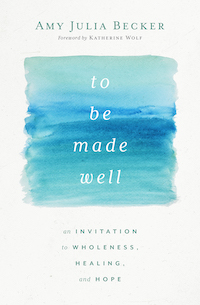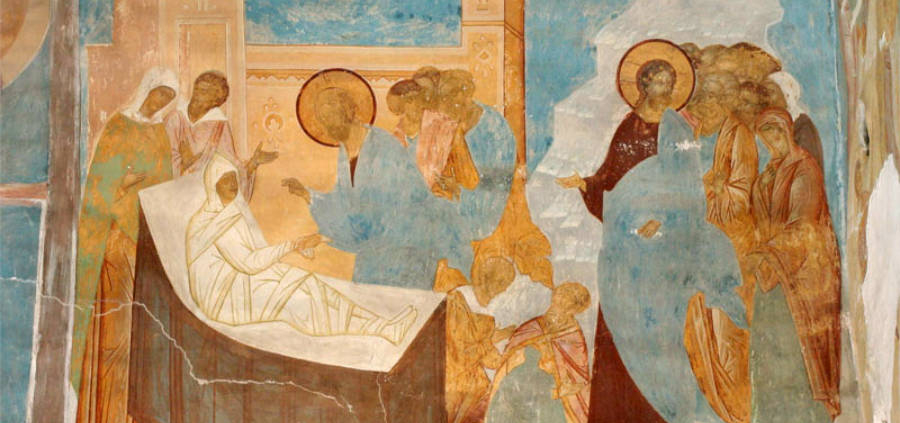Your Faith Has Restored You by Amy Nicholson

To Be Made Well
By Amy Julia Becker
Herald Press, 2022
$17.99 180 pp.
I have always been intrigued by two healings that Mark relates in his Gospel. One story is nested inside the other in chapter 5. The first, which tells of the synagogue ruler Jairus and his daughter, begins in verse 21. Jairus falls at Jesus’s feet, begging him to heal his daughter who is dying. Jesus begins walking with him and a large crowd toward Jairus’s house.
Although this is an urgent mission, and the man pleading with Jesus has status, the young girl’s healing is delayed. Six short verses later, Jesus pauses for someone else. A woman who has been bleeding for 12 years has touched his cloak. She is healed instantly. Feeling the power has gone out of him, Jesus turns and asks who has touched his clothes. The unnamed woman fearfully comes forward and tells him the truth. “And he said unto her, ‘Daughter, thy faith hath made thee whole; go in peace, and be whole of thy plague’” (Mark 5:34 KJV).
Then, before he can resume the journey to Jairus’s house, Jesus and all who are traveling with him learn that Jairus’s daughter has died. “As soon as Jesus heard the word that was spoken, he saith unto the ruler of the synagogue, ‘Be not afraid, only believe’” (Mark 5:36 KJV). Once at the house, Jesus brings the young girl back to life and tells the family to give her something to eat.
Upon hearing these stories for the first time years ago, I was just as impatient as those in the crowd must have been. Why didn’t Jesus go directly to Jairus’s house and heal the girl before she died? This other woman had been suffering for 12 years already. Why didn’t he delay her healing a little while longer so that he could get to the girl in time?
In her latest book, To Be Made Well, Amy Julia Becker shares her own journey of healing—both physical and spiritual—by taking a deep dive into these two biblical stories, revealing the profound lessons we can glean from them. Both stories were miracles of healing, yes; and Jesus did seek to restore these two physical bodies to health; but, as Becker points out, he was doing so much more than that. We see Jesus’s concern is not solely for people’s physical well-being, but even more for their spiritual health. As Becker would learn in her own life, spiritual unrest often leads to physical ailments. It is when we are honest with ourselves and with God about our deeper issues, when we confess our need for Jesus and we fall at his feet like Jairus and the hemorrhaging woman did, that true healing can begin.
The subtitle of To Be Made Well is An Invitation to Wholeness, Healing, and Hope. I found this slim volume just that. Through the exploration of biblical stories and references to numerous other resources, Becker invites the reader to discover ways to restore wholeness and find healing in body and spirit. She also invites us to share a vision of hope for our society. And that vision starts back in the Gospel of Mark, chapter 5.
After meditating on Becker’s insights, I see the broader picture of what God was trying to teach us when he had the unnamed woman show up in the crowd with Jesus on that particular day. Jairus had status, wealth, power. He had a name. And yet, even with all of those things the world holds most dear, Jesus stopped for the unnamed woman, the outcast. She was poor, unclean, and unwanted, and Jesus saw her. Not only did he heal her body, he mended her spirit. He gave her a name: Daughter. Invited her into his family. Restored her back to her community.
The message was not just for the sake of the direct recipient of the bodily healing. After witnessing these miracles and Jesus’s acceptance, especially his compassion for the woman who had been alone for so long, all those surrounding them now had a part to play in the healing of their community and their treatment of the afflicted.
Jesus had done much teaching in various places, and this, too, was a lesson to all those with eyes to see and ears to hear. Jesus healed the ostracized woman in front of a large crowd. Only after he had shown mercy to the least of these did he continue on his journey to tend to the daughter of this man who had everything. And yet, even with his wealth and status, even with his name, Jairus still acknowledged his utter need for Jesus. I now see this story in a whole new light. It’s not just a tale from a dusty book on my shelf. It’s a lesson in social justice.
Many people wonder how a text as ancient as the Bible can be applicable to our lives today. In To Be Made Well, Amy Julia Becker shows us the richness of this book so many of us have built our faith on, and how it does indeed hold important lessons for each new generation. If we dig deep enough and pray for illumination of the Scriptures, we may find ways we can each take steps—however small—towards healing pain in our bodies, our relationships, and our society. ♦
Amy Nicholson hopes to encourage and inspire others through her writing. She has been published in Country Woman, The Old Schoolhouse, The Lookout, and other publications. In addition to writing and discovering grace in ordinary places, Amy substitute teaches. Visit her at: www.amynicholson14.wordpress.com.





Thank you for this review. I have always found the healing of the hemorrhaging woman fascinating on many levels. I see that it is sold on Audible and I have an account. I am very much looking forward to listening to this book next.